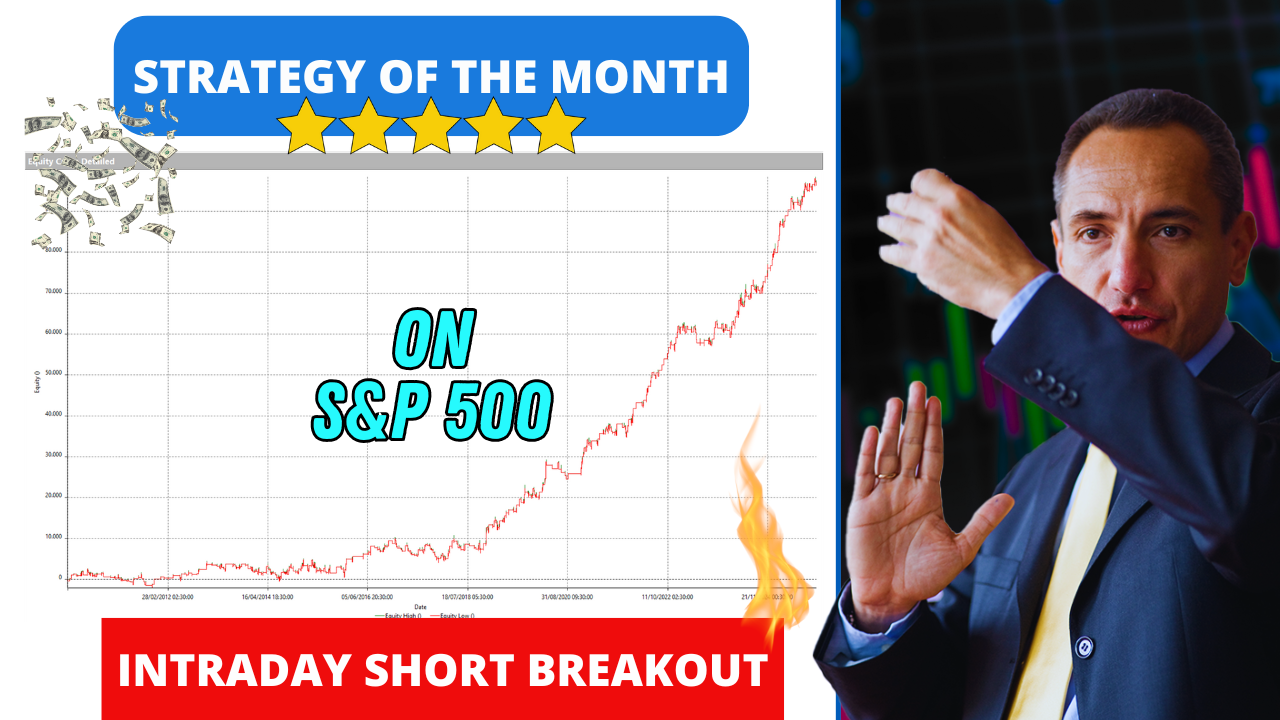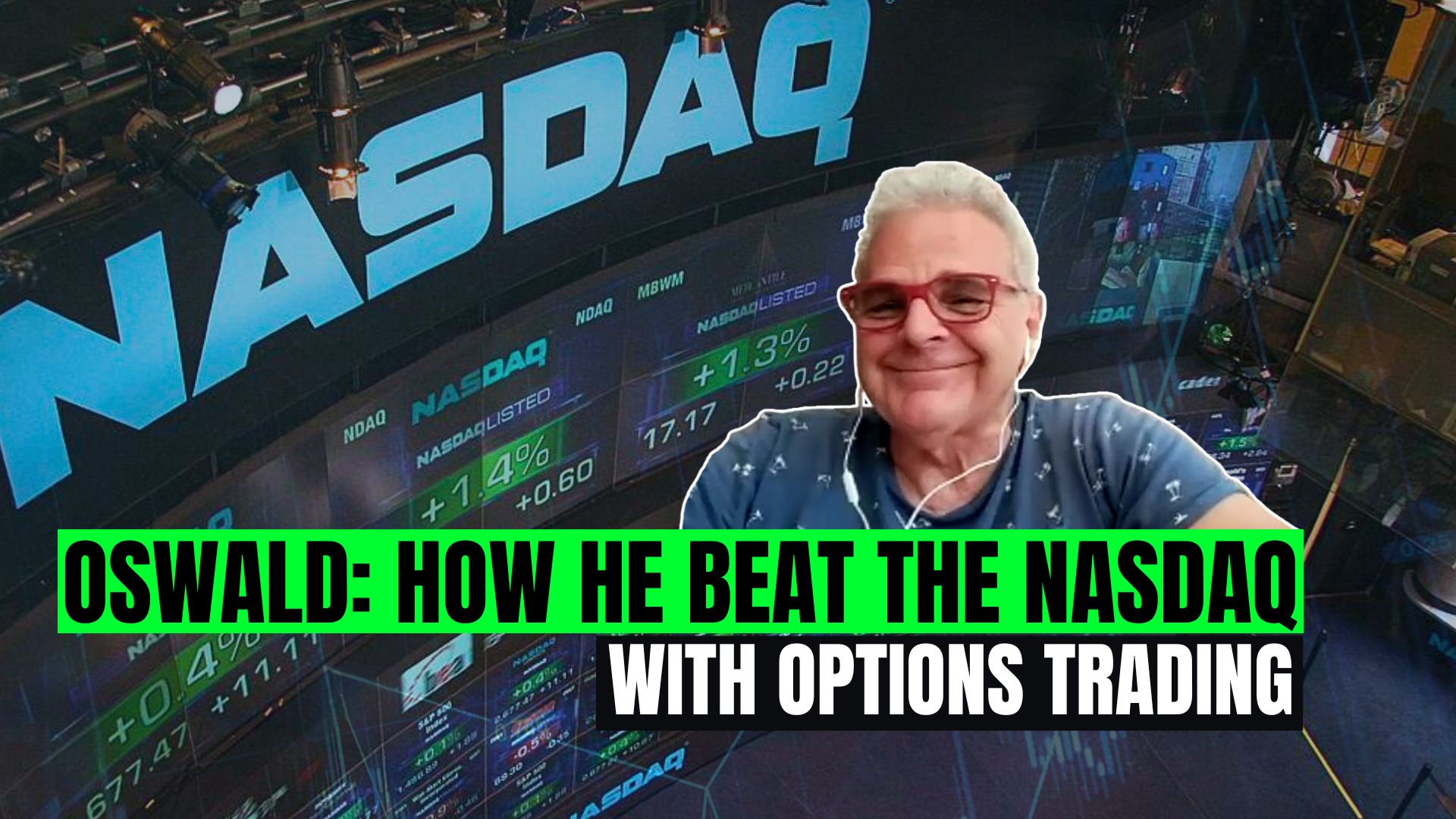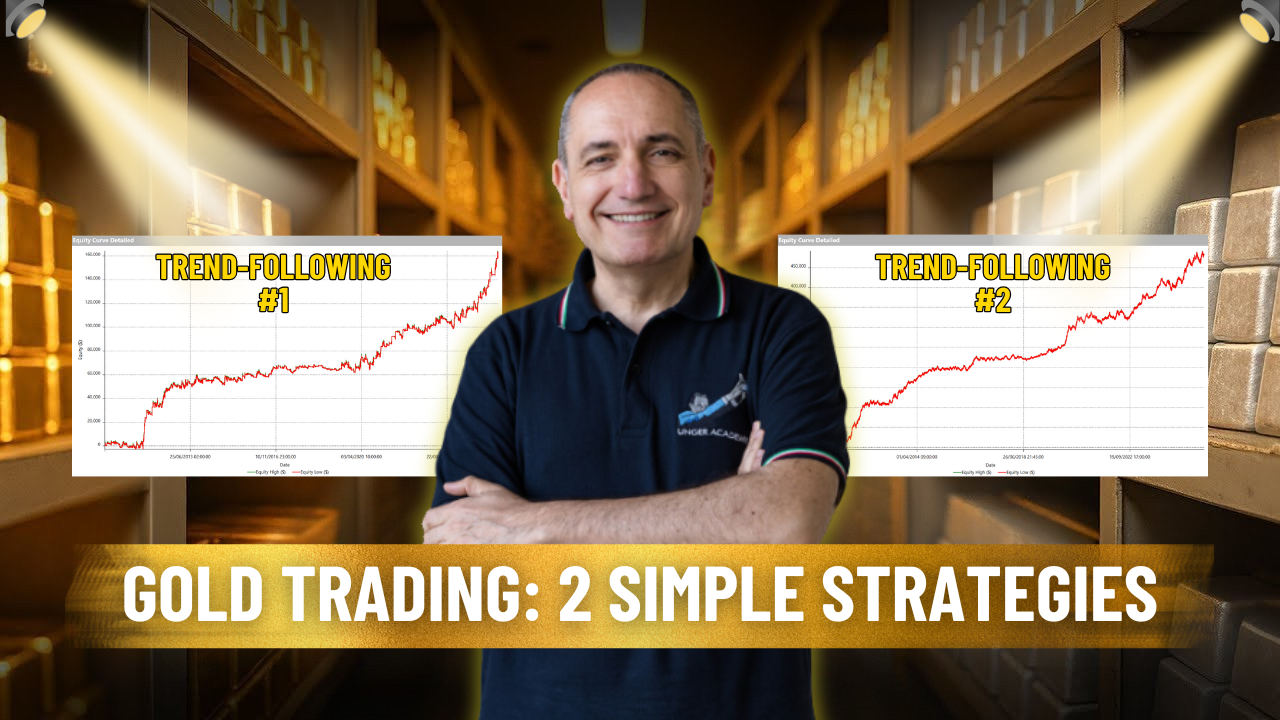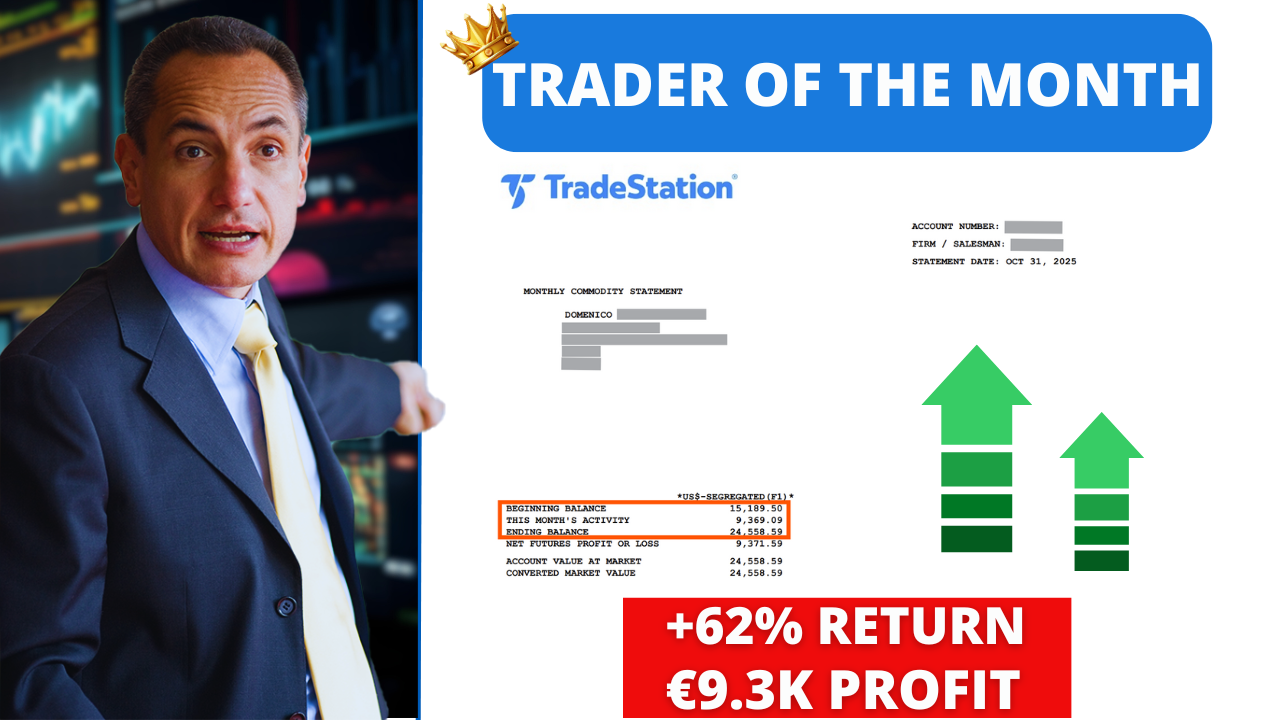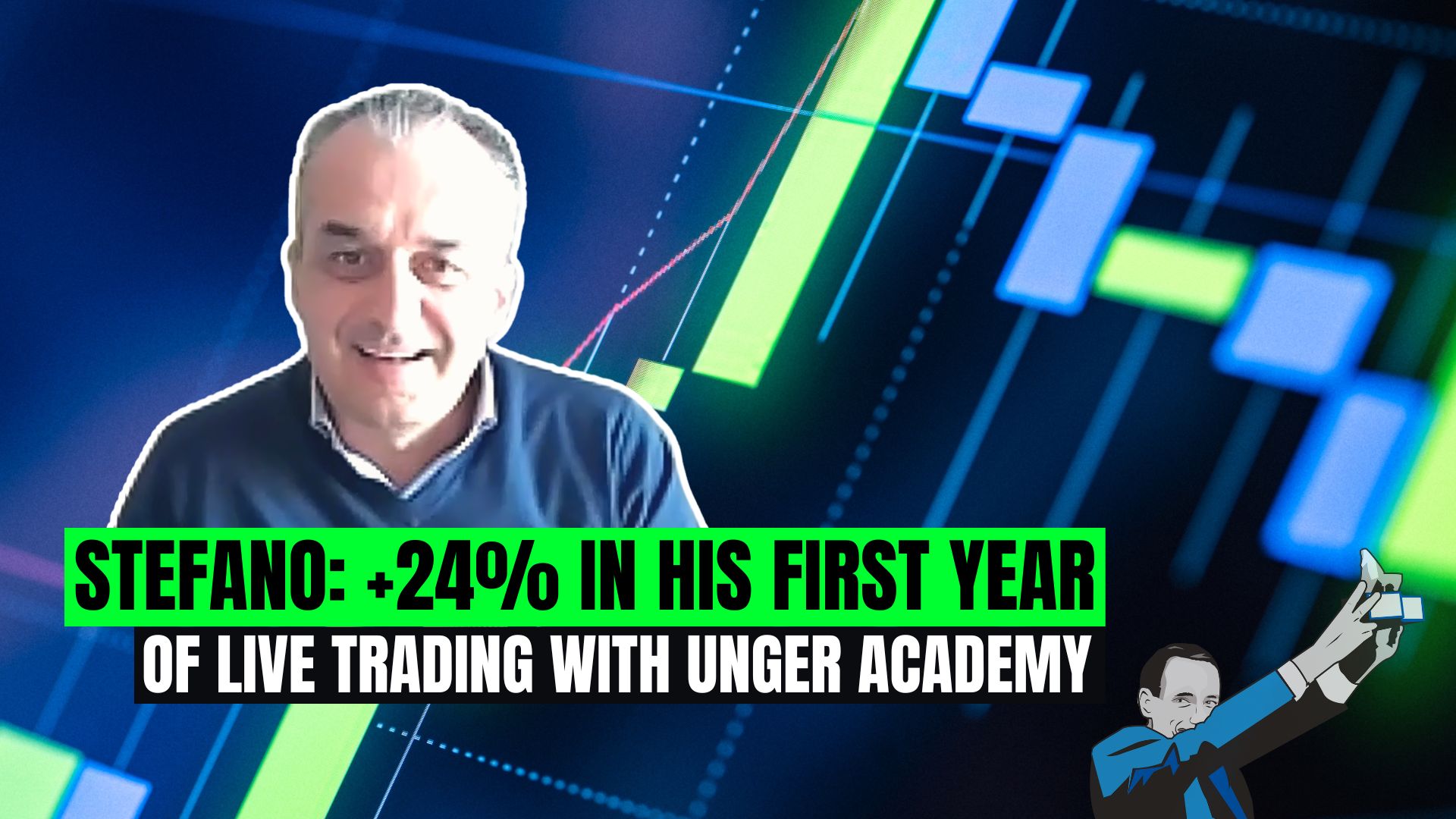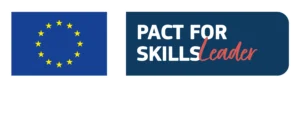Introducing the "Trader of the Year" Contest
Andrea
Hi, everybody. Hi from Andrea Unger and Franz, Francesco Placci.
Francesco
Hi, guys, and welcome.
Andrea
And here we are again to discuss what happened last year in trading, because this time we will not focus only on our personal results, but we also want to give you a comparison with some of our students. We’ve just finished finding out who won the Trader of the Year contest. So, we will be showing you some screenshots of some of the participants. There will be the winner, of course, but not only the top standing, but some we thought would be interesting to share and to discuss about.
Then we will see who was better, if the students or the masters—well, the students! Okay, Franz, can you share, please?
Francesco
Yes.
First Student: 89.9% Performance
Andrea
So perfect. Let’s start immediately with the first equity line. Here it goes. Positive, of course. He would not have participated, if not! With roughly a 90% return, which is outstanding for sure. Interestingly, he started with an affordable capital of about 20K, which is interesting for most of the students because many decide to trade with a similar capital. He was able to roughly double it.
Yes, the ending now is a bit higher because he also deposited another 10K somewhere in the year. We don’t know when, but we know that Interactive Brokers runs the math with their algos to determine exactly what…
Francesco
Probably in the last month?
Andrea
Maybe, yes. In fact, the result… I’m not sure yet. Because of that jump, it’s most probable. But let’s assume it was in the last month. It’s not really important because 89.9% takes it into account, it’s a time-weighted return. So, they take into account the capital at each day or month in this case. This is a monthly statement. We will talk about this a bit later, again.
You can see that the student was very good on the March Soybeans instrument, while he lost money on the November one, maybe, I’m not sure. So, this could lead you and me, and Franz, to probably think that he was spread trading on grains.
It’s possible but it was not necessary to determine this at this stage because in spite of the outstanding performance, he was not one of the candidates for the final victory. So, there was no necessity to dig a little bit deeper into the matter of what exactly he did during the year.
But it’s interesting, and we will probably try to talk to this guy in the future. Maybe we’ll find out something interesting about his activity. Apart from that, micro-Nasdaq is one of the best performers there, while Feeder Cattle is one of the main losers. The same occurred to me. I will show you later. I’m a bit angry because of his good performance on Soybeans, but you will find out later why. But this is it. I mean, 12% drawdown, very good.
Second Student: 91% Performance
This is the second on the list, the second in our choice but he is not in any standing. Very similar performance, very very similar, very close. You can see 91, it was 89, 91, so it’s the same.
Also, the starting capital is more or less 20K, which is again the same. A bit worse drawdown, it’s 17 while it was 12 in the latter case.
In this case, it’s interesting because this guy, or girl, I don’t remember if it’s he or she, diversified very much in terms of instruments. You can see micro-Nasdaq, micro-Gold, and also micro-Copper. I don’t like copper, personally. My systems don’t like copper… well, I created the systems, so I don’t like copper. But I can tell you that since the copper also offers the micro version, it has gained a lot of interest among our students. We find many candidates, not only among the Trader of the Year, but also in the Trader of the Month, many people trading micro-Copper, which is interesting and curious maybe.
But in this case, he wasn’t lucky because he lost money on copper, confirming my dislike of this instrument. This was this guy.
Third Student: Adapting the Unger Method to stocks
Another guy who is certainly interesting is this one. In this case, he sent a daily report, and you can immediately recognize that from the different shape of the equity line, so a much deeper detail. But in spite of this, he got a very great performance of 50%, which is smaller than the other one, but still incredible, of course. A 15% drawdown.
The capital in this case is much higher. He has roughly 160K as a starting capital, which is obviously on a different size, of course. But why do we show this? Because it’s good, of course, but also because you can see, here below, his performance was mostly, if not only on the stock market, on the Nasdaq 100 stocks.
This guy comes from Germany. In Germany, there are some laws, fiscal laws, tax laws that make it difficult to trade efficiently on futures, so he decided to trade on stocks, and he applied the Unger Method to the stock market. I believe –because he won also some Trader of the Month contest in the past—so I think you spoke to this guy in the past, Franz?
Francesco
Correct. I remember he was a very talented guy, very passionate about trading, and he was able to manage the problems of the tax regulation, and he started to experiment with the Unger Method on stocks, and he was able to create a personal Unger Method on some different underlying assets, because when I trade the stocks, I usually trade them on a daily basis.
Instead, this guy was able to trade in intraday with the Unger Method on stocks. It is a very different approach from the standard approach on stocks, we can say. I think this could be an interesting point to deep dive in the future, Andrea.
Andrea
For sure. I can tell you, when Franz talked to me about his interview with this guy and when we both spoke to him, when he detailed a little bit more about his method, I was sort of skeptical because I thought he was a bit overfitting, maybe. He chose the best long performance, the best short performance, trying to adapt the systems depending on the response to up or downtrends. I thought that was a bit too much, in my opinion. Of course, he had 100 stocks or less to trade, so a lot of what he had to filter, of course. I had doubts about his coming performance.
My doubts were completely crazy because he showed us that he did very, very well. So, his approach was absolutely fine, and my doubts vanished. I mean, more than this he could not do to demonstrate that he was right, and I was in the wrong position in that case.
In any case, I wanted, as you mentioned, to have a deeper look into this. The problem is that we have so many things to do that we have not had the time yet to fully dedicate to this matter, but we will try. Maybe 2025 is the right year to work on the stock market as well with the Unger Method.
The Winner of the Trader of the Year Contest
This is our friend on the stock market, but here comes the winner, the annual contest winner, and when you see a performance of 219.85%, you might have no doubt that he for sure is the winner, not only for this, but also because this guy started with an important capital of about 70K, 100 at the beginning plus a deposit of 69,900. It’s about 70,000. He more than doubled – 219%. You can run the math on yourself. What happened? Why are we showing two graphs?
Analysis of drawdown and comparison between monthly and daily data
Not because he had two accounts, and they achieved exactly the same return. No. When we saw that he was leading the competition, but we work on different parameters, return, return over risk, capital, and then a global evaluation of the activity… We wanted to have a deeper detail about his drawdown because on the monthly chart, this is not possible to see, of course.
The guy sent us the daily chart below, and you see immediately, return is obviously the same, but the drawdown, in the first case, was 15, in the second, 32. So it doubled. I mean, the drawdown is the same, but the reading of the different reporting doubled the result. This means on a daily basis, obviously, you can deeper look into it.
In spite of this, the ratio between return and drawdown was above six, which was the second best, I believe, Franz.
Francesco
The second one.
Andrea
The second best. And so there was no doubt that he, considering all the parameters that we take into consideration, was the winner. So, congratulations to David.
And finally, what you see is that their worst return above is 15%, -15, and in the more detailed chart is -10%. This is obviously not because we say this is more severe, so you see worse results. In reality, it is 10%, 11, we say is on a daily basis, while 15 was on a monthly basis. Obviously, it is much, much worse in terms of the risk and heartbreak of the competitor.
Francesco
Also, he was able to diversify his portfolio.
Andrea
Yes, he worked on different futures. You see Nasdaq, Crude Oil, Gold, mini-S&P, of course. But also, I see here two VIX futures. Maybe he opened some spread trading as we describe in the volatility section of our material.
Francesco
Probably, maybe.
Andrea
Maybe. Or he has systems of the VIX futures, maybe as well. But we will talk to him one of these days, so we will discover a bit more about his activity.
Who for sure opened the spreads on the VIX futures and traded volatility is our Franz. Here he comes. This is yours. I let you talk about it.
Franz’s Performance: Focus on options and volatility
Francesco
That’s correct. So, I basically trade volatility because I traded the options and volatility derivatives, so VXX and VIX spreads, but mainly options on SPX and sometimes on the Nasdaq. This was my return, 45%. It’s more than I expected because I usually try to achieve something between 20 and 30%. I’m more focused on the risk side.
So, you know, if you want more, you have to risk more. Passing the years, I’m more than happy with a return between 20 and 30%, but this year was special, we can say.
There was a very big run up in the month of November, probably due to the American elections, because if you take a look at the equity line of the account, the blue one, it seems to me that because of the elections, volatility and time were not paid in the option strategies. How can we explain this, Andrea?
Andrea
Like they were compelled to stay blocked until things were clear…
Francesco
Inside the strategy. And then after the result of the election came out, everything started to go out from the strategy.
Andrea
And this happens more or less every four years in
Francesco
Every four years during the-
Andrea
You see the volatility forward curve, which has a particular shape.
Francesco
Yeah. There is sort of a hill, we can say a hill during the period of the election. And I remember that four years ago, I had some problems, some difficulties trading options and volatility before the election. But immediately after the election, so the market would give back everything I-
Andrea
With interest in this case.
Francesco
It was a nice month, I can say. That’s it. The drawdown is not 5%, I have to admit, because on a daily basis is about 12%.
Andrea
Yeah. Again, it is still twice as much as the monthly basis. On options, it’s less important to show daily because options are more regular rather than futures. But in any case, also, Franz stated that drawdown on a daily basis is more severe than on monthly, clearly.
Andrea Unger’s performance and comparison with students
And very well done, I must admit. And once again, Franz just played on one sector volatility because options embrace volatility. He did better than me because…
Well, first, one thing. I mixed on my account on Interactive Brokers, systems on futures and options, the same trading style as Franz.
Of course, my performance on options was not as good as Franz’s, mostly because I trade smaller compared to him because of his experience, of course, and his knowledge.
I’m approaching that. I’m trying also to change the risk profile, with the years, the age increasing as he mentioned, and it’s a matter of fact, becoming older, you become quieter. This is what I do as well. But I can tell you, I achieved roughly something less than 24% on that account. I did much better on my banking account where I have the asset allocation on ETFs.
This was actually a year for asset allocation because you do nothing, you just invest and sit and wait and you get performance. This is what would have happened in 2024. The problem is that you never know that in advance, so you know it only after. But in any case, I’m not showing you my bank account, of course. I’m not showing the Interactive Brokers account because it’s mixed.
Underperforming sectors in 2024
I want to focus on futures because futures were I must say, in my opinion, disappointing. This is what I was able to extrapolate from my performance through my software Zeus only on the systems on futures that I traded.
The equity line is not bad, actually, after all, but if you look at the number here, you see a 10%, more or less. In reality, it’s nine because the red spot there indicates the portion of run up, which I obviously missed because it was after Christmas, and I switched everything off as usual. I missed that, of course, run up, clearly. It was about 9.3, if I remember well the math, but it’s approximate, of course.
Obviously, it’s disappointing. I achieved roughly 24, which is 23.97, something like that. More than half of that was on options, and Franz confirmed we use the same strategy I just go slower. It was a good year for options. I had a similar equity on options as Franz, confirming that November was a very good month to release all the potential on options. But on the systems of futures, I was missing something.
I said I was missing something because the people that we saw before on the Trader of the Year, they did very well and they were trading systems on futures with the Unger Method. I mean, they are telling me that it was a great year for systems, for them. For me, with my older systems, I didn’t dedicate enough time to the development of new stuff and so on. I’m relying too much sometimes on what I have on my computers already, I didn’t come out very well because 9%, 9 something is disappointing. But again, there are years for asset allocations like this one.
Years for options because very good year for options. But there are years for system trading. So maybe you remember 2022, asset allocation was a disaster.
And the systems went well. In my opinion, the best thing to do is always to diversify as much as possible. Just to dig a bit deeper into the future, because when things go wrong, we want to see what went wrong.
I will show you what did worse in my trading year. And systems on grains, Soybeans, especially. That’s why I was angry with the guy making money on Soybeans. You can see that Soybeans were going nowhere, then started losing. All of a sudden, it showed vitality again. Oh, we’re back, and then it lost everything and took even more out of my pockets. It happens. I’m not happy about that because Soybeans has always been a good instrument to trade. Starting in 2015, it had some years of trouble, and then it started again to boost performance.
This year was very bad, and I paid for the consequences of this turn. Grains are not the only losers in my year, of course, also meats. Here you can see a period of nothing in the beginning.
Actually, the quiet period is because some systems were waiting to be switched on after incubation on the in sample-out of sample rules I use on Zeus. This is Zeus. The problem here with Zeus probably, the fact, because obviously all the performances that you saw have been produced by other instruments, index futures and gold, crude oil as well.
I show you the bad part because it’s from the mistakes that we learned something. On Zeus, you keep systems until they are killed. It’s not like Titan where you switch on, switch off, depending on the performance.
When they’re not doing too bad, they are still there trading. When they exceed a certain threshold of losses that you can put in your system, of course, it’s one of the inputs, they are killed, and they work no more.
In this case, they continue working to the end and they lose money. I mean, 2.5% is a lot of money. Because they made about 9%. Imagine how much they took out.
The meats are a small portion actually, because I don’t have 20 systems of meat. I have some Feeder Cattle, some Live Cattle, some Lean Hogs, but not 20 in total, while I have many more on the other markets.
But they did bad enough to be one of the worst performers of the year. And another disappointing performer is the sector of bonds. Bonds, especially the 30 years bond, the American 30-year bond, did well in the first part, well enough, I mean, decent performance.
Then all of a sudden in autumn, there was the fall of bonds. Okay, let’s forget about that. There was this disaster to the performance of the systems. Maybe it’s due to the new monetary policy, I don’t know. The point is that these systems are all pretty old.
They made money in the past. They trade long and short. They did always most of the money on long trades, of course, but they produce something also, even if not outstanding on short in the bad period for bonds a couple of years ago.
Here, they were not able to respond to what was going on in the markets. It’s a pity because bonds are an important part of what I trade. I was really disappointed seeing that the performance was that bad in this case.
I said totally about about 24%, which is about 50% of what Franz achieved. I believe that he traded aggressively depending on my benchmark. He tweaks his risk profile depending on the level he needs to achieve to beat me every year. And he’s accustomed to that now, and so he wants to keep on the good stream.
Francesco
Last year, you won.
Andrea
Yeah, once in a lifetime. That’s the exception that confirms the rule. So, Franz is a much better trader than I am. And to tell the truth, he is really, because I believe that your knowledge about volatility options is outstanding. It’s great.
And there is a deep knowledge of those markets, a deep knowledge maturated with years of application. This is something that really matters in that trading because we have rules. It’s very simple.
The method you use, which is in the OPT Formula Master, is simple from one point of view, because just to place a certain type of trade, nothing special. But the way that a skilled trader is able to manage it and personalize it is the key, in my opinion, to succeed.
Francesco
Yeah, yeah. Thank you, Andrea.
Andrea
No, it’s something that I could acknowledge. I could appreciate working with you every day. And I see his knowledge. Franz is able to immediately identify something that is wrong.
I mean, if I show a structure or something, look at this. It can’t be. It’s wrong. And obviously, he’s always right. And I must admit that I started hating him very much.
Francesco
Thank you, Andrea.
Andrea
We are just kidding, of course.
Exchange security and risks in cryptocurrency trading
Francesco
We can also add that this year was a crypto year, we can say.
Andrea
Oh, yes.
Francesco
To summarize the outcome of the year: crypto had a very good, very big run up, especially portfolio. My portfolio, my static portfolio on Bitcoin, Ethereum, Solana, and all that.
Andrea
Classic crypto, yeah.
Francesco
But there were also interesting opportunities in the cash and carry strategy because I was able to realize more than 25% on an annual basis. So more or less 18% total return trading with cash and carry strategy.
Andrea
Trading is a big word. You just open a trade, and you wait for it to end.
Francesco
Sort of arbitrage. The only risk that you have is having the money on the exchanges.
Andrea
Yeah, of course. That’s the risk that keeps me a bit from exaggerating on cryptos because there are great opportunities. It’s true, but to put too much money in there is something that frightens me a bit.
Francesco
Yeah. And also, was the year of the meme coin.
Andrea
Yeah, the memecoin is crazy. I have also some investments in crypto. They are all doing so poorly. When I see the meme coin something doing 10,000%, why…It’s incredible, really.
Francesco
But we don’t trade this kind of.
Andrea
That’s not trading, that’s gambling. I’m tempted to put some pennies there just to see what happens. I bought some Trump coins at allall-time high, of course. Just really cheap. Nothing special, just to play a bit.
If it turns a thousand percent, it will not change because it’s so small that I will not become a millionaire in any case. Okay, guys, I think we mentioned everything that would matter about trading in 2024.
Conclusions and reflections on the trading year
Again, congratulations to our Trader of the Year contestants. They did very well. They did better than us, Franz. At least I can say that they were better than you.
So, the students were better than the masters, as usual, especially when we are the masters. And we keep on trying to do our best. And we’ll meet on the next occasion to talk about what happens on the markets. Ciao, everybody.
Francesco
Ciao, guys.

